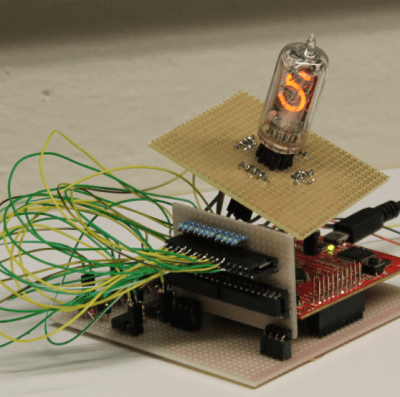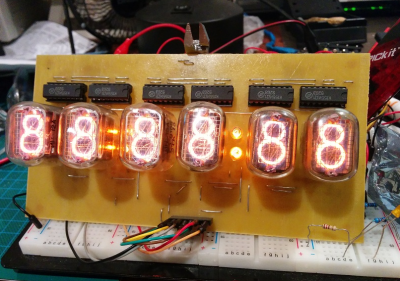Nothing quite beats the warm glow of a tube. What better way to enjoy that glow than to use it to read numbers? Nixie tubes were created by Haydu Brothers Laboratories, and popularized by Burroughs Corp in 1955. The name comes from NIX I – or “Numeric Indicator eXperimental No. 1”. By the mid 1970’s, seven segment LED’s were becoming popular and low-cost alternatives to Nixies, but they didn’t have the same appeal. Nixie tubes were manufactured all the way into the 1990’s. There’s just something about that tube glow that hackers, makers, and humans in general love. This week’s Hacklet highlights the best Nixie (and Nixie inspired) projects on Hackaday.io!
 We start with [Sascha Grant] and Nixie Temperature Display. [Sascha] mixed an Arduino, a Dallas DS18B20 Temperature sensor, and three IN-12A Nixie tubes to create a simple three digit temperature display. We really love the understated laser-cut black acrylic case. An Arduino Pro Micro reads the Dallas 1-wire sensor and converts the temperature to BCD. High voltage duties are handled by a modular HV power supply which bumps 9V up to the required 170V. Controlling the Nixie tubes themselves are the classic K155ID1 BCD to decimal converter chips – a favorite for clock builders.
We start with [Sascha Grant] and Nixie Temperature Display. [Sascha] mixed an Arduino, a Dallas DS18B20 Temperature sensor, and three IN-12A Nixie tubes to create a simple three digit temperature display. We really love the understated laser-cut black acrylic case. An Arduino Pro Micro reads the Dallas 1-wire sensor and converts the temperature to BCD. High voltage duties are handled by a modular HV power supply which bumps 9V up to the required 170V. Controlling the Nixie tubes themselves are the classic K155ID1 BCD to decimal converter chips – a favorite for clock builders.
 Next up is [Christoph] with Reading Datasheets and Driving Nixie Tubes. Chips like the K155ID1, and the 74141 make driving Nixie tubes easy. They convert Binary Coded Decimal (BCD) to discrete outputs to drive the cathodes of the Nixie. More importantly, the output drivers of this chip are designed to handle the high voltages involved in driving Nixie tubes. These chips aren’t manufactured anymore though, and are becoming rare. [Christoph] used more common parts. His final drive transistor is a MPSA42 high voltage NPN unit. Driving the MPSA42’s is a 74HC595 style shift register. [Christoph] used a somewhat exotic Texas Instruments TPIC6B595 with FET outputs, but any shift register should work here. The project runs on a Stellaris Launchpad, so it should be Arduino compatible code.
Next up is [Christoph] with Reading Datasheets and Driving Nixie Tubes. Chips like the K155ID1, and the 74141 make driving Nixie tubes easy. They convert Binary Coded Decimal (BCD) to discrete outputs to drive the cathodes of the Nixie. More importantly, the output drivers of this chip are designed to handle the high voltages involved in driving Nixie tubes. These chips aren’t manufactured anymore though, and are becoming rare. [Christoph] used more common parts. His final drive transistor is a MPSA42 high voltage NPN unit. Driving the MPSA42’s is a 74HC595 style shift register. [Christoph] used a somewhat exotic Texas Instruments TPIC6B595 with FET outputs, but any shift register should work here. The project runs on a Stellaris Launchpad, so it should be Arduino compatible code.
 [Davedarko] has the fixietube clock. Fixietube isn’t exactly a Nixie. It’s an LED based display inspired by Nixie tubes. Modern amber LEDs aren’t quite the same as classic Nixies, but they get pretty darn close. [Dave] designed a PCB with a 3×5 matrix of LEDs to display digits. A few blue LEDs add a bit of ambient light. The LEDs are driven with a 74HC595 shift register. The entire assembly mounts inside a tiny glass jam jar, giving it the effect of being a vacuum tube. The results speak for themselves – fixietubes certainly aren’t Nixies, but they look pretty darn good. Add a nice 3D printed case, and you’ve got a great project which is safe for anyone to build.
[Davedarko] has the fixietube clock. Fixietube isn’t exactly a Nixie. It’s an LED based display inspired by Nixie tubes. Modern amber LEDs aren’t quite the same as classic Nixies, but they get pretty darn close. [Dave] designed a PCB with a 3×5 matrix of LEDs to display digits. A few blue LEDs add a bit of ambient light. The LEDs are driven with a 74HC595 shift register. The entire assembly mounts inside a tiny glass jam jar, giving it the effect of being a vacuum tube. The results speak for themselves – fixietubes certainly aren’t Nixies, but they look pretty darn good. Add a nice 3D printed case, and you’ve got a great project which is safe for anyone to build.
 Finally, we have [Johnny.drazzi] with his Open Nixie Clock Display. [Johnny] has been working on Open Nixie for a few years. The goal is to create a Nixie based clock display which can be driven over the SPI bus. So far, [Johnny] has 6 Russian IN-12 tubes glowing with the help of the ubiquitous K155ID1 BCD to decimal converter. The colons of the clock are created with two INS-1 neon indicators. [Johnny] spends a lot of time analyzing the characteristics of a Nixie tube – including the strike voltage, and steady state current. If you’re interested in building a Nixie circuit yourself, his research is well worth a read!
Finally, we have [Johnny.drazzi] with his Open Nixie Clock Display. [Johnny] has been working on Open Nixie for a few years. The goal is to create a Nixie based clock display which can be driven over the SPI bus. So far, [Johnny] has 6 Russian IN-12 tubes glowing with the help of the ubiquitous K155ID1 BCD to decimal converter. The colons of the clock are created with two INS-1 neon indicators. [Johnny] spends a lot of time analyzing the characteristics of a Nixie tube – including the strike voltage, and steady state current. If you’re interested in building a Nixie circuit yourself, his research is well worth a read!
Not satisfied? Want more Nixie goodness? Check out our Nixie tube project list!
That’s about all the time we have for this week’s Hacklet. As always, see you next week. Same hack time, same hack channel, bringing you the best of Hackaday.io!















I’d say that K155ID1’s are overrated. I have a bunch of them, but I tend to use multiplexed nixies with MPSA42 transistors.
BTW: we used to call them ‘digitrons’, not nixies. I was pretty confused when hearing the term nixie for the first time.
Oh, and then there are numitrons, another safe and easy to work with alternative, still giving you that nice warm glow.
since nixies are ‘back in style’ again, I should probably put a post together about my own open source nixie clock:
http://www.netstuff.org/nixie_clock.jpg
gps driven, of course, but also has some other tricks up its sleeve. I had some fun doing the casework for it, too (the case was not planned, btw; it just evolved once I put the perf board together and then built the case around the populated board).
anyway, that’s my nixie contribution to the clock club ;) I’ll try to write it up and maybe it will join the ranks of H.A.D. nixies.
Wow, great design! Definitely looking forward to the write-up!
YES! Please do send in a write up… I’m drooling!
ok, its next on my list. its arduino-based (hopefully that does not turn people off, lol) and uses existing modules so that you don’t have to reinvent everything from scratch. right now, its just hand wired proto:
https://farm3.staticflickr.com/2911/14243181359_ba938b729f_o.jpg
https://c4.staticflickr.com/4/3912/14247168030_bf321a1dbc_c.jpg
and no one is going to want to build THAT if they can use a proper pcb, instead. so, I have to do the pcb work and once that is done, it will be post-worthy has a DIY.
some features: gps receiver (optional), xbee receiver (optional), IR receiver (shows date and satellite/gps status, etc), web interface (gui and REST) via a serial connection to a rasp pi or similar and finally, a single rgb light for extended status or mode indication (ideally trying to light up the plexiglass top like a lightpipe).
anyway, thanks for the encouragement and I’ll try to make a proper project page for it soon.
Great clock! If you do write it up, I can almost guarantee you’ll be on the front page!
For everyone who is to lazy to build a controller himself, here is a great offer for you:
http://www.ebay.com/itm/VFD-Nixie-tube-Module-Limited-Arduino-Compatible-Free-Shipping-/281589399120?
(only 4 left, you might want to write the seller if he has additional stock of these)
This is his website – as you can see: He loves Nixies!
http://www.nixieclock.org/
They forgot about us! http://hackaday.io/project/214-obsolete-time
https://cdn.hackaday.io/images/4533921414248200444.jpg
I got you guys back in the tube Hacklet – http://hackaday.com/2014/11/21/hacklet-23-the-groove-tube/
You’re definitely on the nixie list though!
Sure, just wanted to show us off here too.
No problem – I love that wood and nixie look!
“There’s just something about that (nixie) tube glow that hackers, makers, and humans in general love.” Don’t forget the shape of the numbers too, can’t get that with 7 segment LEDs.
I made one too. http://www.thingiverse.com/thing:52252
http://thingiverse-production.s3.amazonaws.com/renders/41/e4/5b/fa/67/IMG_20130219_163950_preview_featured.jpg
Makes me wish I hadn’t got rid of that corn seeder monitor a few years back! (Yep!-Nixies)
Nixies are the best. I still enjoy my Warm Tube Clock project on http://www.elektronika.ba
Here is the picture of it: http://www.elektronika.ba/img-cont/c/c_800_v2_1.jpg
The reason I took the TPIC6B595 was
1. I had some and did not look for alternatives
2. I was thinking about driving the NIXIs directly with the output stage (FETs)
I stepped back from that idea because the max. Voltage is rated 50V. However as technics1979 mentioned on my project page it does work and the outputs are clamped with internal zeners. The expected cathode voltage of NIXIs is still giving me a headache so I played on the save side, rating for NIXI-Supply-Voltage.
Regarding the chosen register: Yes: in the given constellation any shift register would work.
However the TPIC6B595 (or any similar one) seems to be able do drive NIXIs directly even so it’s out of specs.